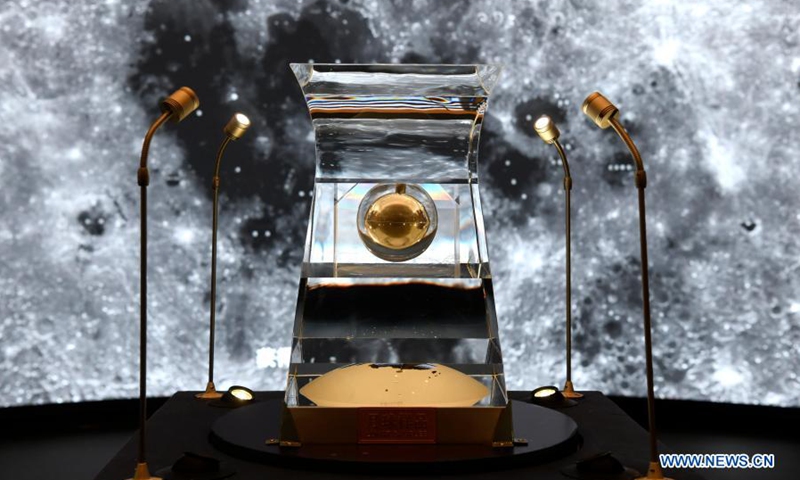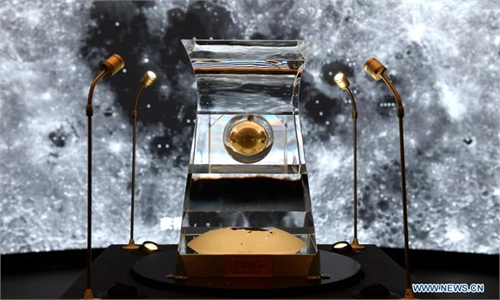Chinese scientists discover new findings from Chang'e-5 samples, provide new insights into lunar volcanic activity

The lunar samples No. 001 brought back by China's Chang'e-5 probe is displayed at the National Museum of China in Beijing, on February 27, 2021. Photo: Xinhua
Scientists with the Chinese Academy of Sciences (CAS) have conducted more studies and research into lunar samples from the Chang'e-5 robotic mission, which revealed the basalt thickness at its landing region and they estimated that the region has experienced volcanic eruptions at least four times, according to a recent article published on the CAS website.
The Chang'e-5 mission successfully brought 1,731 grams of lunar minerals back to Earth. The landing site in the Northeastern Oceanus Procellarum basin (43.06°N, 51.92°W) of the Moon was considered to have one of the youngest basalt units on the lunar surface with rich heat-generating elements such as uranium, thorium and potassium.
Previous studies have indicated that these elements were the main cause of lunar volcanic activities, which explains the significance of the new findings by Chinese tests. They are also expected to further enhance people's understanding of lunar volcanic activity and internal thermal evolution history.
Chinese scientists including Du Jun, Liu Yang with the CAS State Key Laboratory of Solar Activities and Space Weather and researchers with Peking University, CAS Shanghai Astronomical Observatory and Shandong University made estimates about the basalt thickness at the Chang'e-5 landing region.
Their findings show that the region has experienced at least four volcanic lava eruptions, and the mean value of the basalt thickness is estimated to be 230 meters, 70 meters, four meters and 36 meters.
Their studies also show that the volume of lava eruption saw significant enhancement during the late lunar volcanic active phase, which was some 2 billion years ago.
The late lunar volcanic active phase has always been a hot issue in lunar scientific research, according to the CAS, and further research on the Chang'e-5 basalt samples is expected to provide new insights for the existing lunar thermochemical and kinetic models, providing strong evidence for the duration and scale of the volcanic activity.
By studying samples retrieved by China's Chang'e-5 mission, Chinese researchers revealed high water content in lunar minerals, and said the findings would offer the world direct evidence for the existence of water on the Moon, verifying previous monitoring outcomes, the Global Times reported on Monday.
And on September 9, Chinese scientists announced that for the first time they discovered a new mineral on the Moon and named it Changesite-(Y), making China the third country to make a discovery of a new mineral on the moon.


